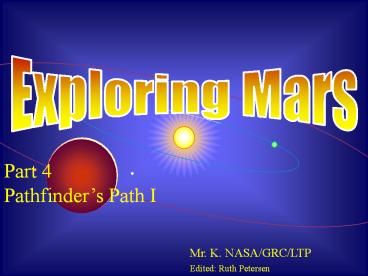Exploring Mars - PowerPoint PPT Presentation
Title:
Exploring Mars
Description:
What role did Mars play in the discovery of Kepler's law of ... Kepler's study of Mars' orbit lead him to the discovery that planetary orbits were ellipses. ... – PowerPoint PPT presentation
Number of Views:148
Avg rating:3.0/5.0
Title: Exploring Mars
1
Exploring Mars
.
Part 4 Pathfinders Path I
Mr. K. NASA/GRC/LTP Edited Ruth Petersen
2
- Preliminary Activities
- (Use the URLs provided on Slide 21 to complete
the preliminary activities.) - Who were Tycho Brahe and Johannes Kepler? What
did they contribute to modern astronomy and space
exploration? - 2. Write down Keplers three laws of planetary
motion. Why are these laws significant today? - 3. What role did Mars play in the discovery of
Keplers law of planetary orbits?
3
4. Why is Mars significant today? 5. In your
algebra class, discuss the conic sections. Write
the equation for an ellipse with its center at
the origin. 6. What role do the conic sections
play in planetary and spacecraft orbits?
4
(No Transcript)
5
(No Transcript)
6
Every planet travels in an ellipse with the sun
at one focus.
The radius vector from the sun to the planet
sweeps equal areas in equal times.
The square of the planets period is proportional
to the cube of its mean distance from the sun.
7
Keplers study of Mars orbit lead him to the
discovery that planetary orbits were ellipses.
Actually, we know now that orbits can be any
conic section, depending on the total energy
involved.
8
The Conic Sections
Circle Ellipse Parabola Hyperbola
9
The Ellipse
y
x
S1 S2 Constant
10
Keplers First law Elliptical Orbits
Planet
Sun
The sun is located at one of the two foci of the
ellipse.
11
Vis Viva
Conservation of Energy ½mv2 - GMm/r K
v
m
r
M
v 2(K GMm/r)/m 1/2
12
Vis Viva (Continued)
How are v and r related?
Faster
Slower
M
As r increases, v decreases vice versa.
13
Pathfinders Path
Earth's Orbit
Mars' Orbit
14
Pathfinders Path
Arrival July 1997
Departure December 1996
15
The Conic Sections - Revisited
Circle Ellipse Parabola Hyperbola
Open orbits Some comets Parabolic velocity
escape velocity
Closed orbits Planets, moons, asteroids,
spacecraft.
16
Follow-Up Activities 1. Earth orbits the sun at a
mean distance of 1.5 X 108 km. It completes one
orbit every year. Compute its orbital velocity in
km. sec. 2. The Pathfinder required a greater
velocity than Earth orbital velocity to achieve
its transfer orbit. Why? Since additional
velocity costs NASA money for fuel, can you
explain why we launched the spacecraft eastward?
(Hint When viewed from celestial north, the
Earth and planets orbit the sun
counter-clockwise.)
17
3. The equation for an ellipse with its center at
the origin is (x/a)2 (x/b)2 1 Under what
mathematical condition does the ellipse become a
circle? (Check with your algebra teacher if
necessary.) 4. Plot the ellipse choosing
different values of a and b. (a lt b a b a gt
b). What do you observe? 5. In the Vis-Viva
equation for velocity, how does the velocity vary
around a CIRCULAR orbit?
18
6. Extra CreditThe ellipse is defined as a locus
of points p such that for two points, f1 and f2
(the foci), the sum of the distances from f1 and
f2 to p is a constant. Use this definition and
your knowledge of algebra to show that the
equation of an ellipse follows i.e., that (x/a)2
(y/b)2 1 where a and b are the x and y
intercepts respectively.
19
Solution to 6 The Setup
y
P(x,y)
(0,b)
s2
s1
(a,0)
x
(f ,0)
(f,0)
(-a,0)
(0,-b)
20
Solution to 6 The Algebra Given s1
s2 k (f - x)2 y2 s12
(eq. i) (f x)2 y2
s22 (eq. ii) 1.) Let (x,y) (a,o). This gives
k 2a, and s1 2a - s2 2.) Let (x,y) (0,b).
This gives s1 s2 (f2b2)1/2, and f2 a2 -
b2 3.) Result 2.) ? eq. ii gives s2 a
(x/a)(a2 - b2)1/2 4.) Result 2.) and 3.) ? eq. ii
gives (x/a)2 (y/b)2 1
From geometry
Be careful The algebra gets messy!
21
Johannes Kepler csep10.phys.utk.edu/astr161/lect
/history/kepler.html www.vma.bme.hu/mathhist/Math
ematicians/Kepler.html Tycho Brahe http//www-g
roups.dcs.st-andrews.ac.uk/history/Mathematicians
/Brahe.html Hohmannn Transfer Orbits http//www.
jpl.nasa.gov/basics/bsf-toc.htm
22
joseph.c.kolecki_at_grc.nasa.gov































